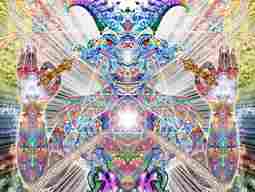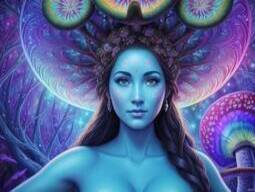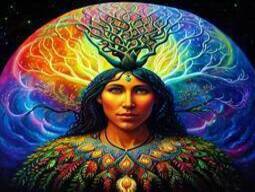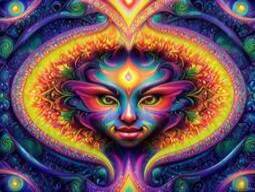Is DMT Produced By The Pineal Gland?
What is the Pineal gland? What is its link to DMT? Is DMT produced by our brains? Is this fiction or fact?

Between both hemispheres is the Pineal gland
What is the Pineal gland?
The human brain is composed of two hemispheres. These hemispheres are connected by the corpus callosum. The pineal gland is located between the two around the center of the brain. The pineal gland acts as the body’s time keeper.
The pineal gland looks a bit like a pine cone. This is why it is called “pine"eal. It’s slightly reddish gray and just about the size of rice grain in humans.
History of the Pineal Gland
For as long as the pineal has been discussed in history, it has represented enlightenment, and held the symbolism of spirituality. The pineal represents a “higher consciousness” in many cultures across the world. “Throughout the span of recorded human history, Pinecones have served as a symbolic representation of Human Enlightenment, the Third Eye and the Pineal Gland.”
The pineal gland and it’s activity is not fully understood. Throughout mankind’s history, the pineal has been thought to be greatly important. It has been linked with the origin of consciousness itself.
In Hinduism, the pineal gland is referred to as the Third Eye, or the Ajna. The Greeks believed that the production of thought was because of the pineal gland. Rene Descartes himself thought that the pineal was “the principal seat of the soul and the place in which all our thoughts are formed.”
The Staff or Osiris in Egyptian Mythology which dates to roughly 1200 B.C. is two serpents climbing up to meet at a pinecone. The Hindu concept of the Kundalini is very similar to this, which are two serpents that climb up from the naval to meet at the pineal gland.
The symbolism of the pineal across all cultures represents divine knowledge and enlightenment. Read about Historical and cultural aspects of the pineal gland: comparison between the theories provided by Spiritism in the 1940s and the current scientific evidence from NCBI here.
Become an Exclusive Member For Free
Become a member now, sign up, and get free updates, news articles, and the latest happenings in the Psychedelic World.
What Does The Pineal Gland Do?
The pineal gland regulates the sleep and wake rhythms of the body. This in turn effects our stress levels, physical energy, and mental functioning. Poor sleep patterns can induce irritability. It also causes a lack of clear and sharp thinking. When stress gets too high, obtaining a restful sleep becomes more difficult.
Anatomy And Function of the Pineal Gland
Pineal gland primarily produces a chemical called melatonin, which is a serotonin analog. Melatonin regulates the organism’s sleep and wake cycles, and is responsible for the functioning of our circadian rhythms. Higher amounts of melatonin are produced in the dark. In absolute pitch black, the pineal gland is fully activated. Light interferes with melatonin production. Learn About the Anatomy of the Pineal Gland from Thought Co.
The function of melatonin is to provide information about environmental light sources and intensity to various parts of the organism’s body. This allows the organism to know how to operate at the proper time of day. Melatonin is kind of like an invisible eye.
Melatonin’s ability to communicate lighting information has led to the pineal gland being called the “third eye”.
Is DMT Produced in the Pineal Gland?
It seems that a lot of people have associated DMT with the pineal gland based on some conjectures made by Dr. Rick Strassmanand because of a video made by the beloved and famous comedian Joe Rogan, where he claims that DMT is “the craziest drug ever” and that it’s produced by the pineal gland in our brains. What Is DMT? By Joe Rogan
It’s produced by your pineal gland. It’s actually a gland that’s in the centre of the brain. It’s the craziest drug ever. It’s the most potent psychedelic known to man. But the craziest thing about it is it’s natural. And your brain produces it every night as you sleep. The time you’re in heavy REM sleep and right before death, your brain pumps out heavy doses of dimethyltryptamine…When you’re in heavy REM sleep, you’re going through a psychedelic trip. Very few people know about this. But it’s been documented.
Rick Strassman - “We don’t know whether DMT is made in the pineal”
I did my best in the DMT book to differentiate between what is known, and what I was conjecturing about (based upon what is known), regarding certain aspects of DMT dynamics. However, it’s amazing how ineffective my efforts seem to have been. So many people write me, or write elsewhere, about DMT, and the pineal, assuming that the things I conjecture about are true. When I was writing the book, I thought I was clear enough, and repeating myself would have gotten tedious.
We don’t know whether DMT is made in the pineal. I muster a lot of circumstantial evidence supporting a reason to look long and hard at the pineal, but we do not yet know. There are data suggesting urinary DMT rises in psychotic patients when their psychosis is worse. However, we don’t know whether DMT rises during dreams, meditation, near-death, death, birth or any other endogenous altered state. To the extent those states resemble those brought on by giving DMT, it certainly makes one wonder if endogenous DMT might be involved, and if it were, it would explain a lot. But we don’t know yet.
Even if the pineal weren’t involved, that would have little overall effect on my theories regarding a role for DMT in endogenous altered states, because we do know that the gene involved in DMT synthesis is present in many organs, particularly lung. If the pineal made DMT, it would tie up a lot of loose ends regarding this enigmatic little organ. But people seem to live pretty normals lives without a pineal gland; for example, when it has had to be removed because of a tumor.
David Nichols - DMT And The Pineal Gland: Facts vs Fantasy
David Nichols gave an illuminating talk on this subject as well.
The pineal gland has a romantic history, from pharaonic Egypt, where it was equated with the eye of Horus, through various religious traditions, where it was considered the seat of the soul, the third eye, etc. Recent incarnations of these notions have suggested that DMT is secreted by the pineal at birth, during dreaming, and at near death to produce out of body experiences. Scientific evidence, however, is not consistent with these ideas.
The adult pineal gland weighs less than 0.2 grams, and its principal function is to produce 30 micrograms per day of melatonin, a hormone that regulates circadian rhythm through very high a nity interactions with melatonin receptors. Very minute concentrations of DMT have been detected in brain, but they are not sufficient to produce psychoactive effects. Alternative explanations will be presented to explain how stress and near death can produce altered states of consciousness without invoking DMT.
DMT Has Been Found in the Pineal Gland of Live Rats
Dr. Jimo Borjigin’s at the University of Michigan conducting research on DMT has found DMT in the pineal glands of live rats. “These samples were analyzed in Dr. Steven Barker’s laboratory at Louisiana State University, using methods that funding from the Cottonwood Research Foundation helped develop.”
Current Evidence Does not Support the Claim that DMT is Produced by the Pineal
Currently, there is no hard proof that DMT is produced in the brain. Pineal Gland myths? Research has not found the enzymes required for NMT and DMT production to be expressed in the brain. The metabolic pathways of melatonin production (proven function of the pineal) seem to be separate from the metabolic pathway which produces NMT and DMT. However, just because one avenue of study turned up negative certainly doesn’t mean that the answer is final. Do Our Brains Produce DMT, And If So, Why?
DMT found in the pineal gland of live rats is a recent discovery.
More research is needed before we can determine the link between DMT, consciousness and the pineal gland. Consciousness and its origin is the reason for looking at the pineal gland as even before neurochemistry, the pineal has been granted a great seat of importance through the history of mankind through various cultures.
Perhaps science coupled with the non-scientific knowledge of our ancestors may be the way to shedding more light on this link. Why has the pineal gland been exalted throughout man’s history?
Sources:
- Rick Strassman
- DMT and the Pineal: Fact or Fiction? BY JON HANNA
- Pineal Gland, Wikipedia
- David Nichols - DMT And The Pineal Gland: Facts vs Fantasy
- THE DMT-NEXUS SITE - Pineal Gland myths?
- DMT Found in the Pineal Gland of Live Rats
- Do Our Brains Produce DMT, And If So, Why?
- What Is DMT? By Joe Rogan
- “Third Eye and the Pineal Gland.”
- Historical and cultural aspects of the pineal gland
- An Overview of the Pineal Gland
- Learn About the Function of the Pineal Gland
































